GMC SAVANA 2003 Workshop Manual
Manufacturer: GMC, Model Year: 2003, Model line: SAVANA, Model: GMC SAVANA 2003Pages: 392, PDF Size: 2.34 MB
Page 51 of 392
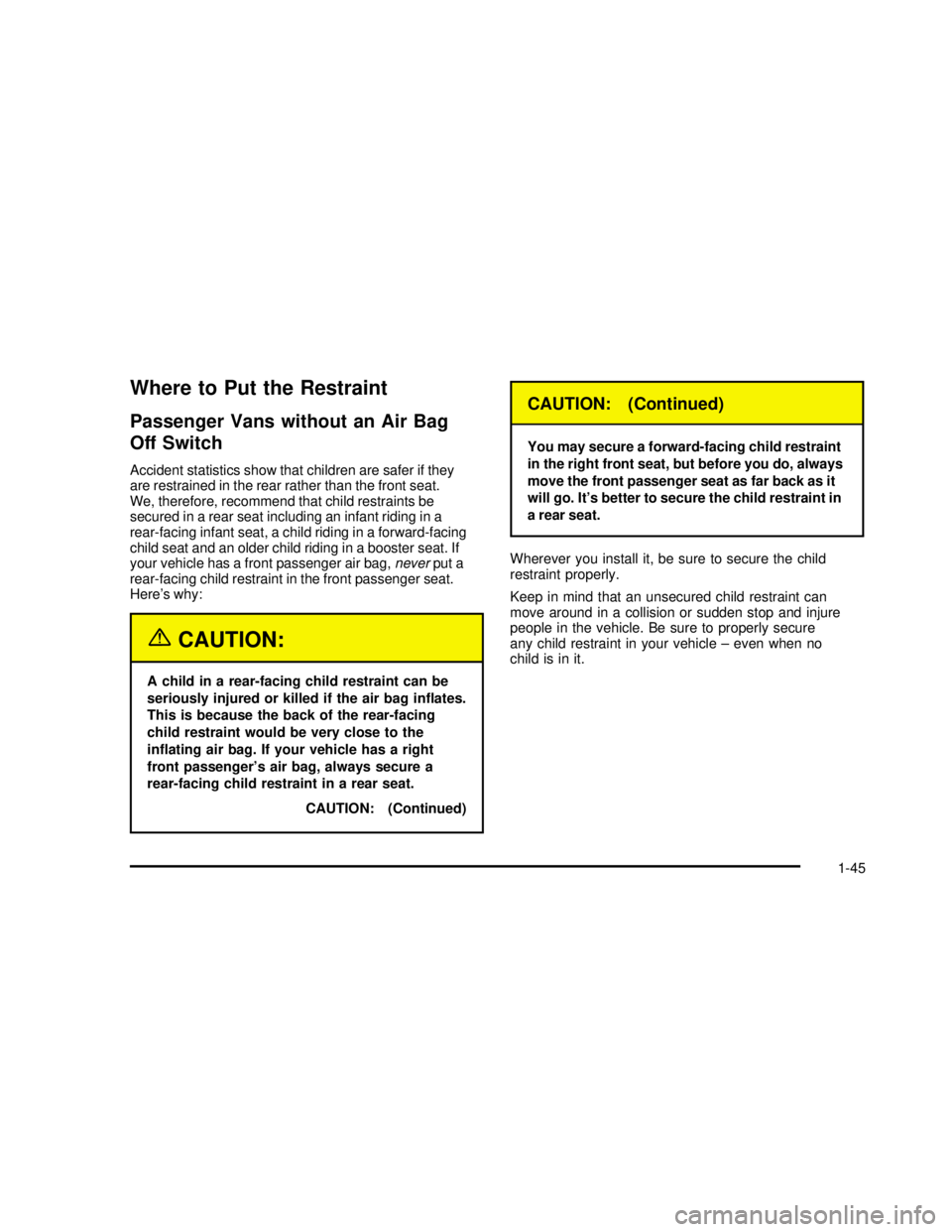
Where to Put the Restraint
Passenger Vans without an Air Bag
Off Switch
Accident statistics show that children are safer if they
are restrained in the rear rather than the front seat.
We, therefore, recommend that child restraints be
secured in a rear seat including an infant riding in a
rear-facing infant seat, a child riding in a forward-facing
child seat and an older child riding in a booster seat. If
your vehicle has a front passenger air bag,neverput a
rear-facing child restraint in the front passenger seat.
Here’s why:
{CAUTION:
A child in a rear-facing child restraint can be
seriously injured or killed if the air bag inflates.
This is because the back of the rear-facing
child restraint would be very close to the
inflating air bag. If your vehicle has a right
front passenger’s air bag, always secure a
rear-facing child restraint in a rear seat.
CAUTION: (Continued)
CAUTION: (Continued)
You may secure a forward-facing child restraint
in the right front seat, but before you do, always
move the front passenger seat as far back as it
will go. It’s better to secure the child restraint in
a rear seat.
Wherever you install it, be sure to secure the child
restraint properly.
Keep in mind that an unsecured child restraint can
move around in a collision or sudden stop and injure
people in the vehicle. Be sure to properly secure
any child restraint in your vehicle–even when no
child is in it.
1-45
2003 - Savana OM
Page 52 of 392
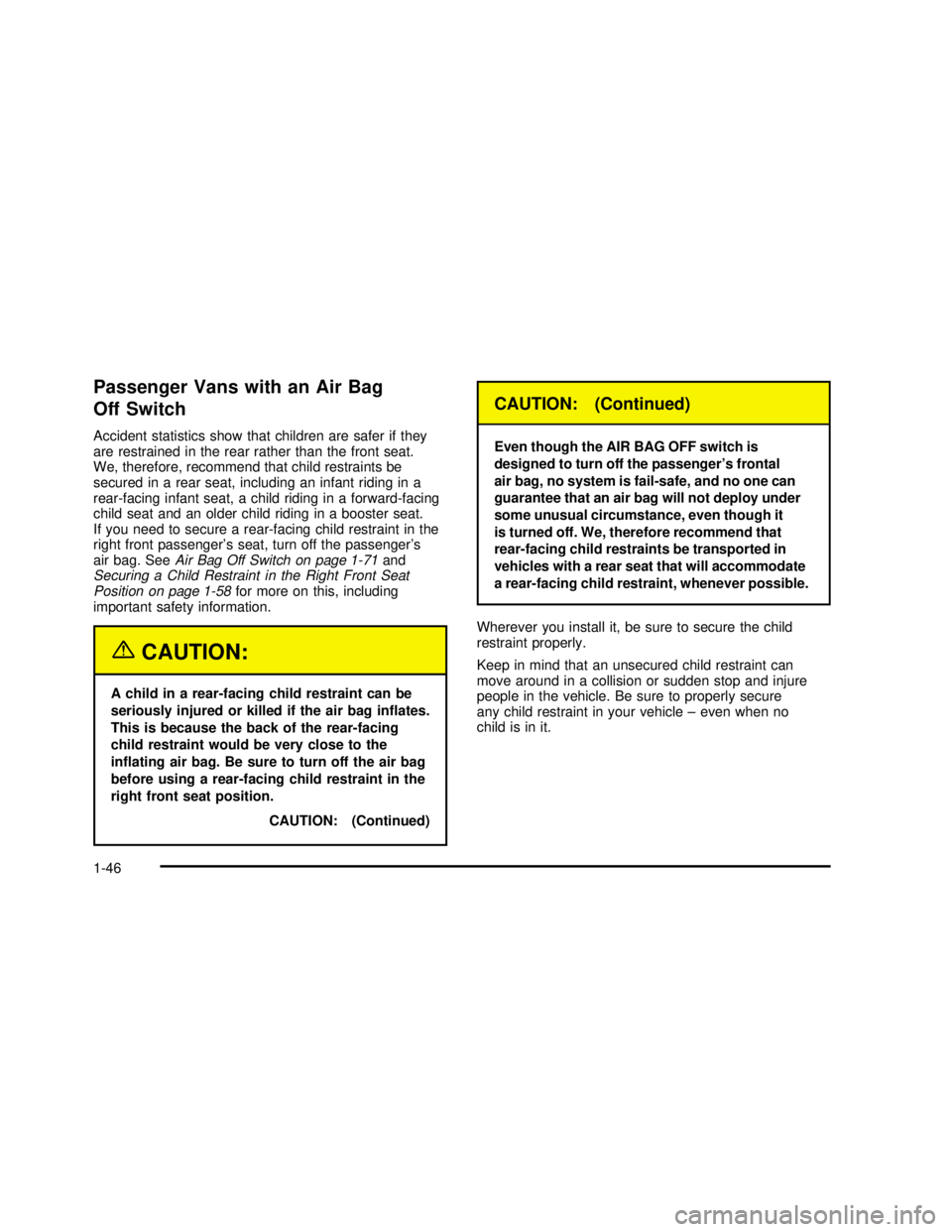
Passenger Vans with an Air Bag
Off Switch
Accident statistics show that children are safer if they
are restrained in the rear rather than the front seat.
We, therefore, recommend that child restraints be
secured in a rear seat, including an infant riding in a
rear-facing infant seat, a child riding in a forward-facing
child seat and an older child riding in a booster seat.
If you need to secure a rear-facing child restraint in the
right front passenger’s seat, turn off the passenger’s
air bag. SeeAir Bag Off Switch on page 1-71and
Securing a Child Restraint in the Right Front Seat
Position on page 1-58for more on this, including
important safety information.
{CAUTION:
A child in a rear-facing child restraint can be
seriously injured or killed if the air bag inflates.
This is because the back of the rear-facing
child restraint would be very close to the
inflating air bag. Be sure to turn off the air bag
before using a rear-facing child restraint in the
right front seat position.
CAUTION: (Continued)
CAUTION: (Continued)
Even though the AIR BAG OFF switch is
designed to turn off the passenger’s frontal
air bag, no system is fail-safe, and no one can
guarantee that an air bag will not deploy under
some unusual circumstance, even though it
is turned off. We, therefore recommend that
rear-facing child restraints be transported in
vehicles with a rear seat that will accommodate
a rear-facing child restraint, whenever possible.
Wherever you install it, be sure to secure the child
restraint properly.
Keep in mind that an unsecured child restraint can
move around in a collision or sudden stop and injure
people in the vehicle. Be sure to properly secure
any child restraint in your vehicle–even when no
child is in it.
1-46
2003 - Savana OM
Page 53 of 392
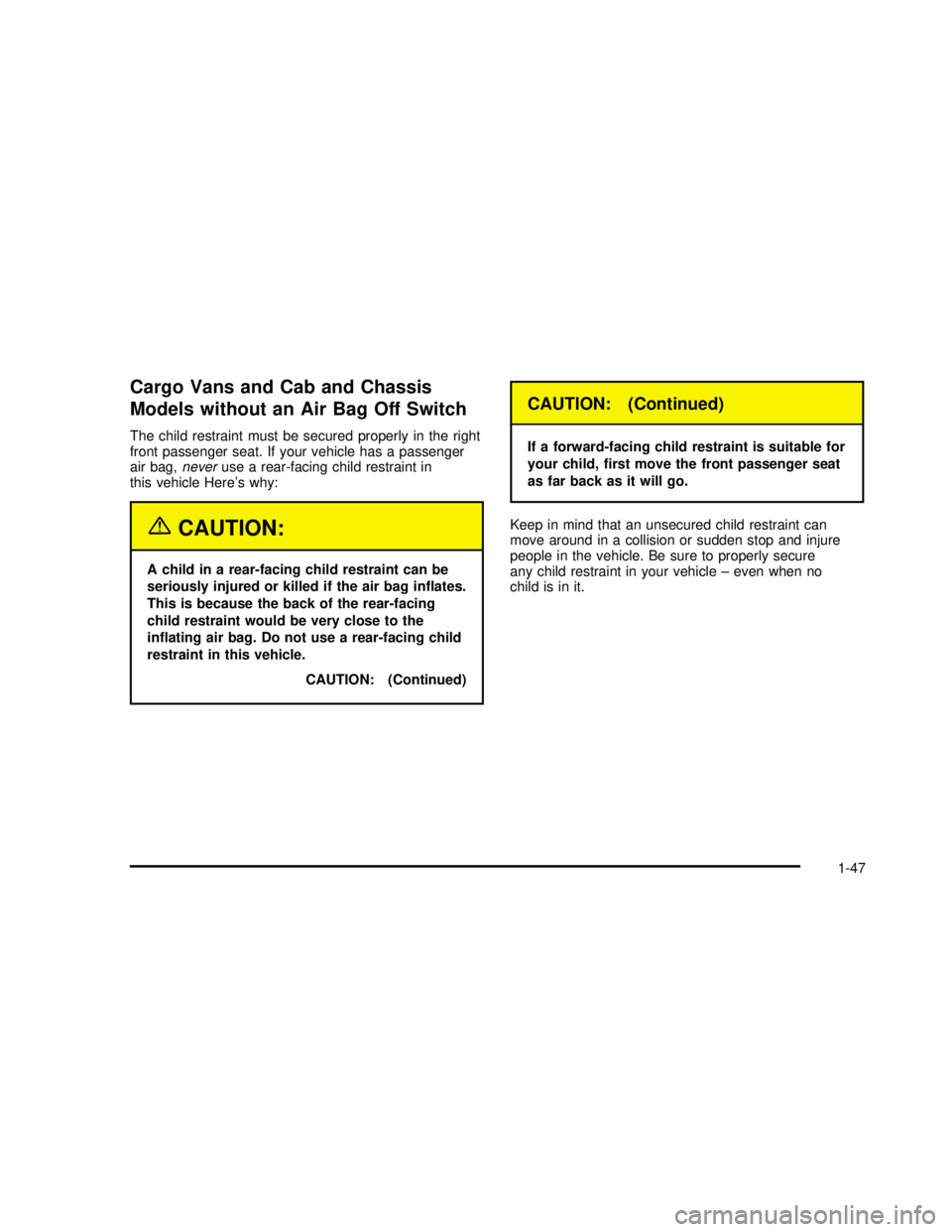
Cargo Vans and Cab and Chassis
Models without an Air Bag Off Switch
The child restraint must be secured properly in the right
front passenger seat. If your vehicle has a passenger
air bag,neveruse a rear-facing child restraint in
this vehicle Here’s why:
{CAUTION:
A child in a rear-facing child restraint can be
seriously injured or killed if the air bag inflates.
This is because the back of the rear-facing
child restraint would be very close to the
inflating air bag. Do not use a rear-facing child
restraint in this vehicle.
CAUTION: (Continued)
CAUTION: (Continued)
If a forward-facing child restraint is suitable for
your child, first move the front passenger seat
as far back as it will go.
Keep in mind that an unsecured child restraint can
move around in a collision or sudden stop and injure
people in the vehicle. Be sure to properly secure
any child restraint in your vehicle–even when no
child is in it.
1-47
2003 - Savana OM
Page 54 of 392
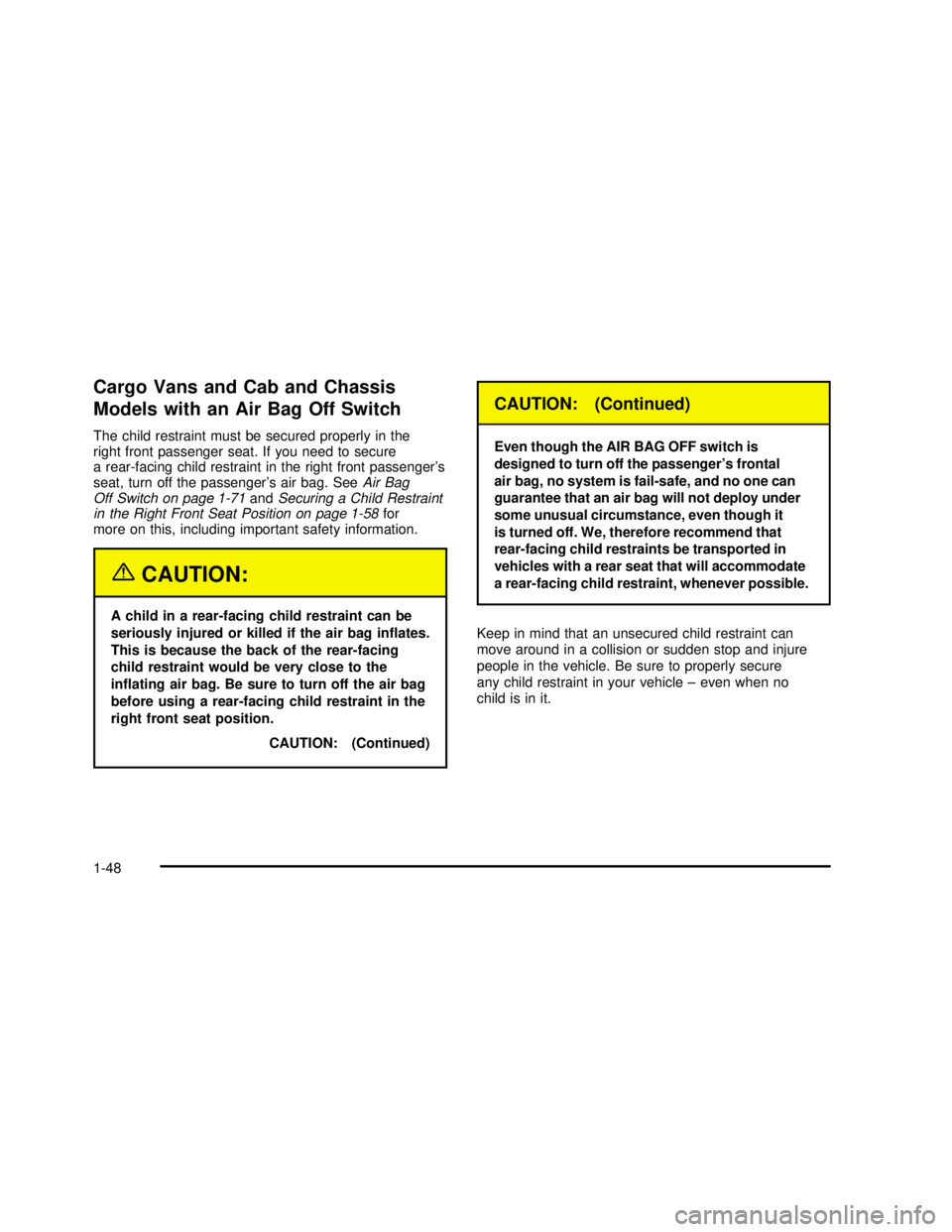
Cargo Vans and Cab and Chassis
Models with an Air Bag Off Switch
The child restraint must be secured properly in the
right front passenger seat. If you need to secure
a rear-facing child restraint in the right front passenger’s
seat, turn off the passenger’s air bag. SeeAir Bag
Off Switch on page 1-71andSecuring a Child Restraint
in the Right Front Seat Position on page 1-58for
more on this, including important safety information.
{CAUTION:
A child in a rear-facing child restraint can be
seriously injured or killed if the air bag inflates.
This is because the back of the rear-facing
child restraint would be very close to the
inflating air bag. Be sure to turn off the air bag
before using a rear-facing child restraint in the
right front seat position.
CAUTION: (Continued)
CAUTION: (Continued)
Even though the AIR BAG OFF switch is
designed to turn off the passenger’s frontal
air bag, no system is fail-safe, and no one can
guarantee that an air bag will not deploy under
some unusual circumstance, even though it
is turned off. We, therefore recommend that
rear-facing child restraints be transported in
vehicles with a rear seat that will accommodate
a rear-facing child restraint, whenever possible.
Keep in mind that an unsecured child restraint can
move around in a collision or sudden stop and injure
people in the vehicle. Be sure to properly secure
any child restraint in your vehicle–even when no
child is in it.
1-48
2003 - Savana OM
Page 55 of 392
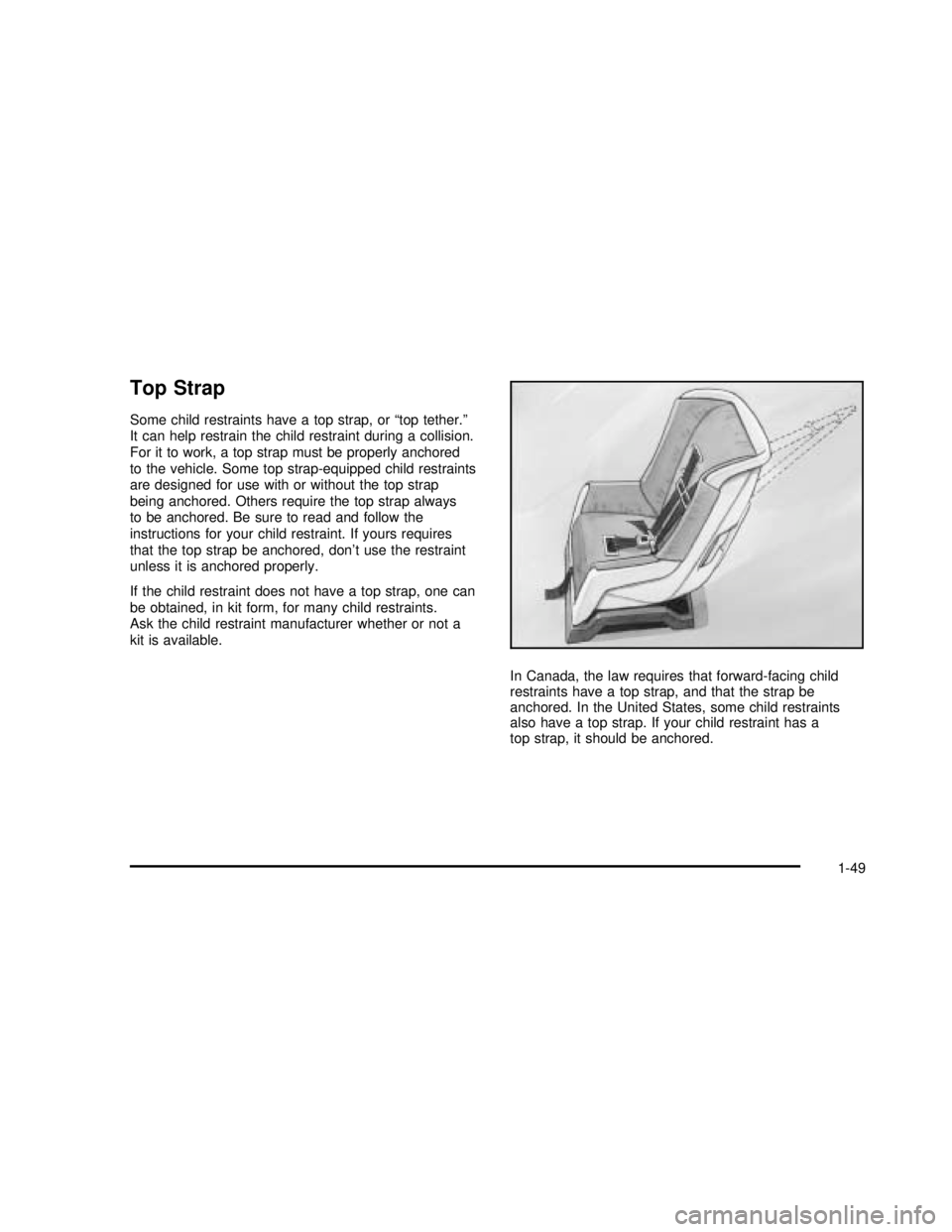
Top Strap
Some child restraints have a top strap, or“top tether.”
It can help restrain the child restraint during a collision.
For it to work, a top strap must be properly anchored
to the vehicle. Some top strap-equipped child restraints
are designed for use with or without the top strap
being anchored. Others require the top strap always
to be anchored. Be sure to read and follow the
instructions for your child restraint. If yours requires
that the top strap be anchored, don’t use the restraint
unless it is anchored properly.
If the child restraint does not have a top strap, one can
be obtained, in kit form, for many child restraints.
Ask the child restraint manufacturer whether or not a
kit is available.
In Canada, the law requires that forward-facing child
restraints have a top strap, and that the strap be
anchored. In the United States, some child restraints
also have a top strap. If your child restraint has a
top strap, it should be anchored.
1-49
2003 - Savana OM
Page 56 of 392
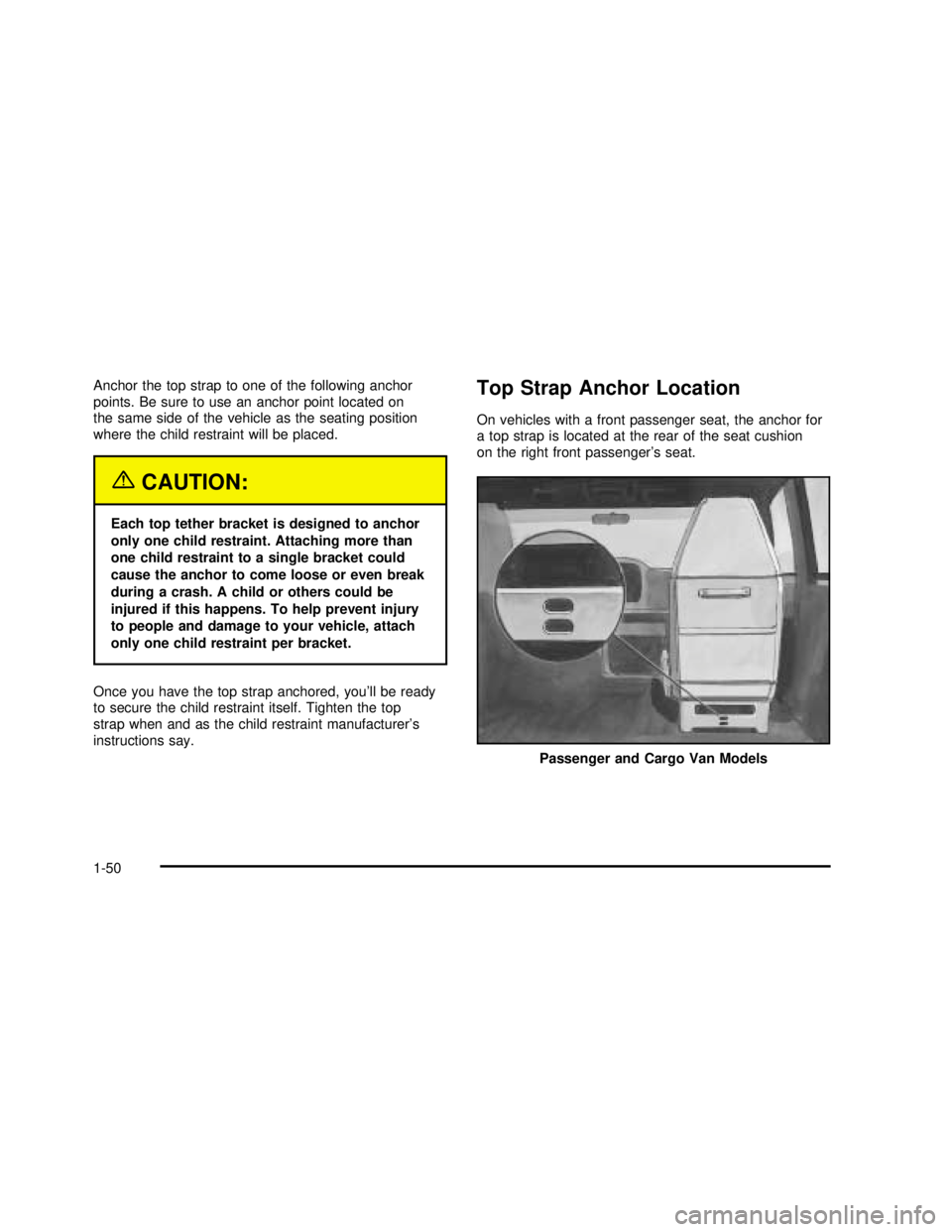
Anchor the top strap to one of the following anchor
points. Be sure to use an anchor point located on
the same side of the vehicle as the seating position
where the child restraint will be placed.
{CAUTION:
Each top tether bracket is designed to anchor
only one child restraint. Attaching more than
one child restraint to a single bracket could
cause the anchor to come loose or even break
during a crash. A child or others could be
injured if this happens. To help prevent injury
to people and damage to your vehicle, attach
only one child restraint per bracket.
Once you have the top strap anchored, you’ll be ready
to secure the child restraint itself. Tighten the top
strap when and as the child restraint manufacturer’s
instructions say.
Top Strap Anchor Location
On vehicles with a front passenger seat, the anchor for
a top strap is located at the rear of the seat cushion
on the right front passenger’s seat.
Passenger and Cargo Van Models
1-50
2003 - Savana OM
Page 57 of 392
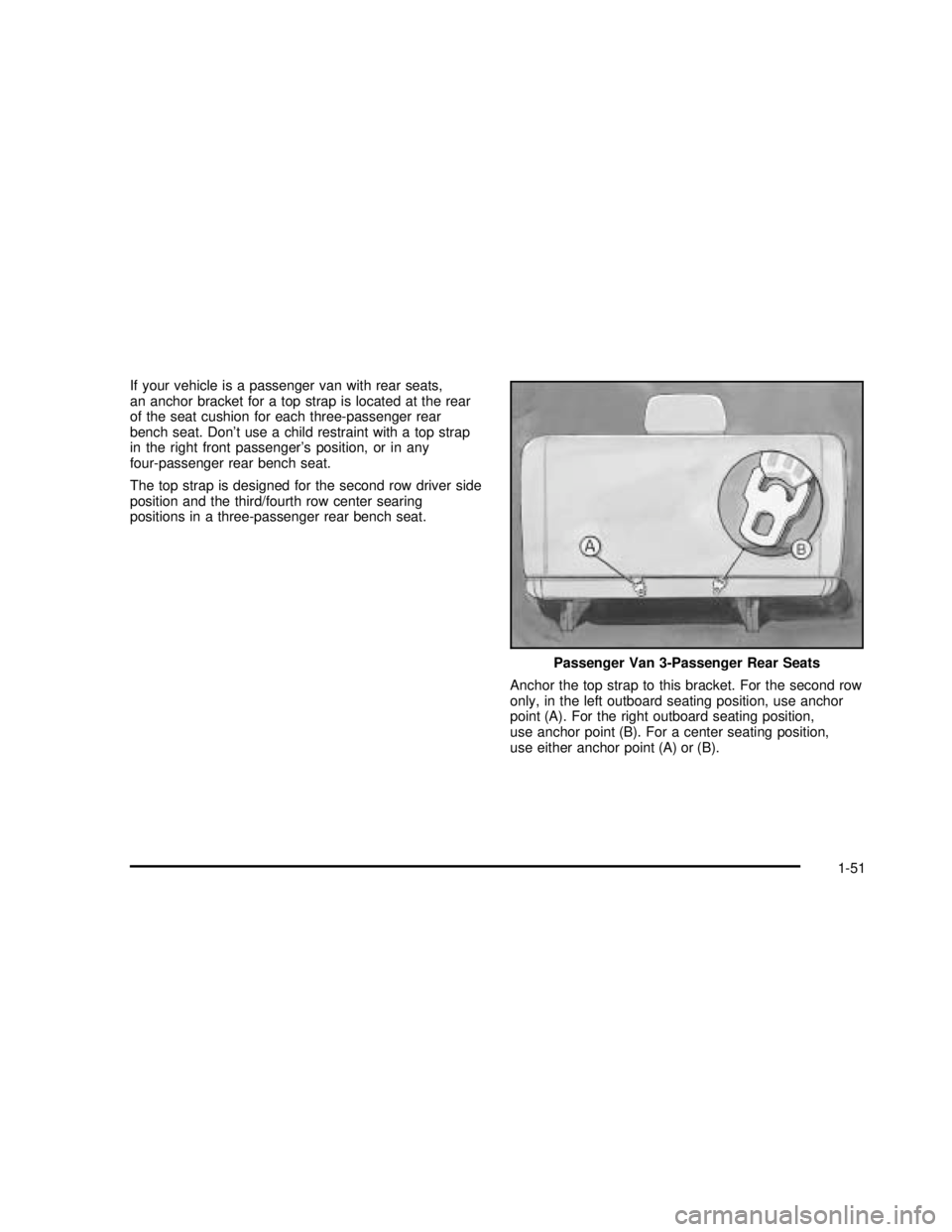
If your vehicle is a passenger van with rear seats,
an anchor bracket for a top strap is located at the rear
of the seat cushion for each three-passenger rear
bench seat. Don’t use a child restraint with a top strap
in the right front passenger’s position, or in any
four-passenger rear bench seat.
The top strap is designed for the second row driver side
position and the third/fourth row center searing
positions in a three-passenger rear bench seat.
Anchor the top strap to this bracket. For the second row
only, in the left outboard seating position, use anchor
point (A). For the right outboard seating position,
use anchor point (B). For a center seating position,
use either anchor point (A) or (B).Passenger Van 3-Passenger Rear Seats
1-51
2003 - Savana OM
Page 58 of 392
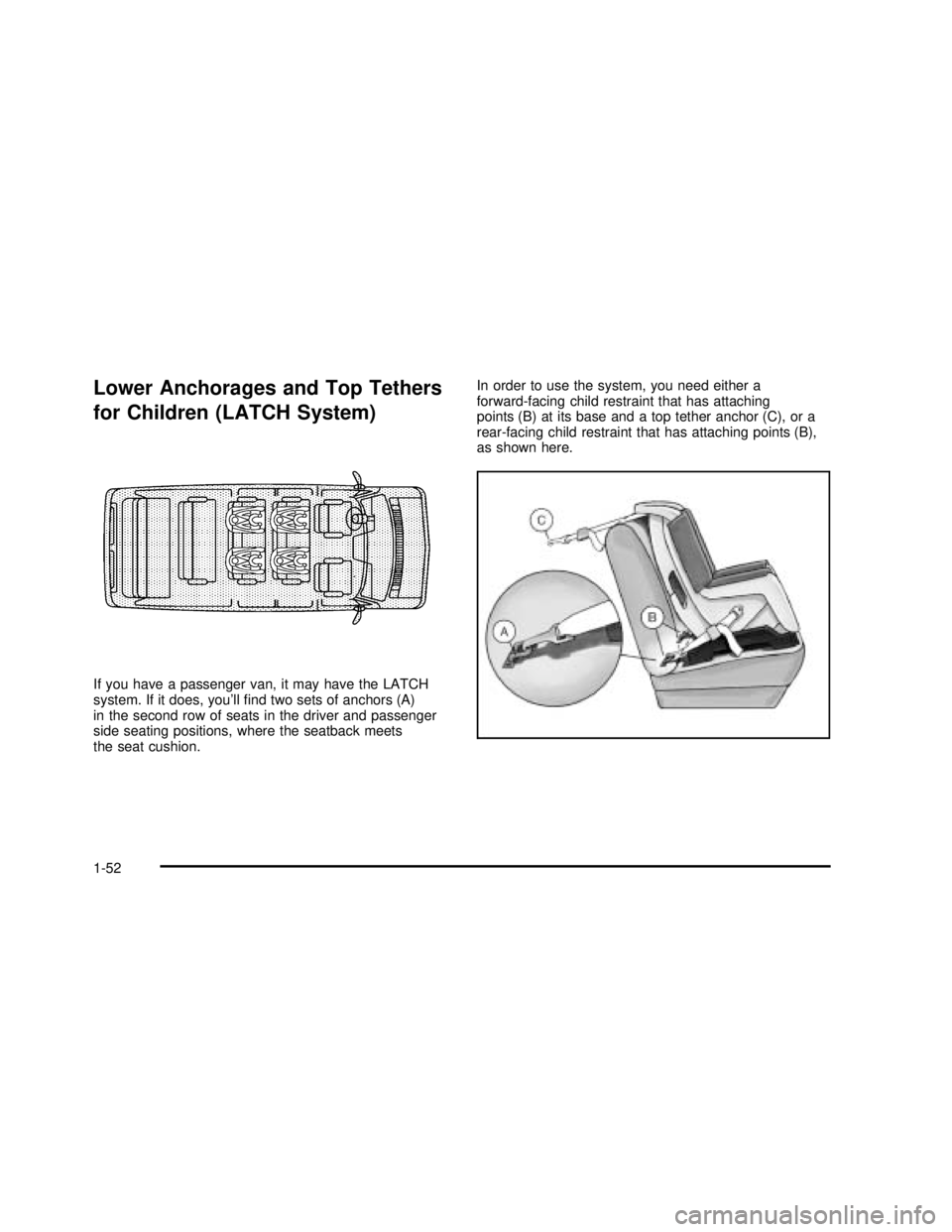
Lower Anchorages and Top Tethers
for Children (LATCH System)
If you have a passenger van, it may have the LATCH
system. If it does, you’llfind two sets of anchors (A)
in the second row of seats in the driver and passenger
side seating positions, where the seatback meets
the seat cushion.In order to use the system, you need either a
forward-facing child restraint that has attaching
points (B) at its base and a top tether anchor (C), or a
rear-facing child restraint that has attaching points (B),
as shown here.
1-52
2003 - Savana OM
Page 59 of 392
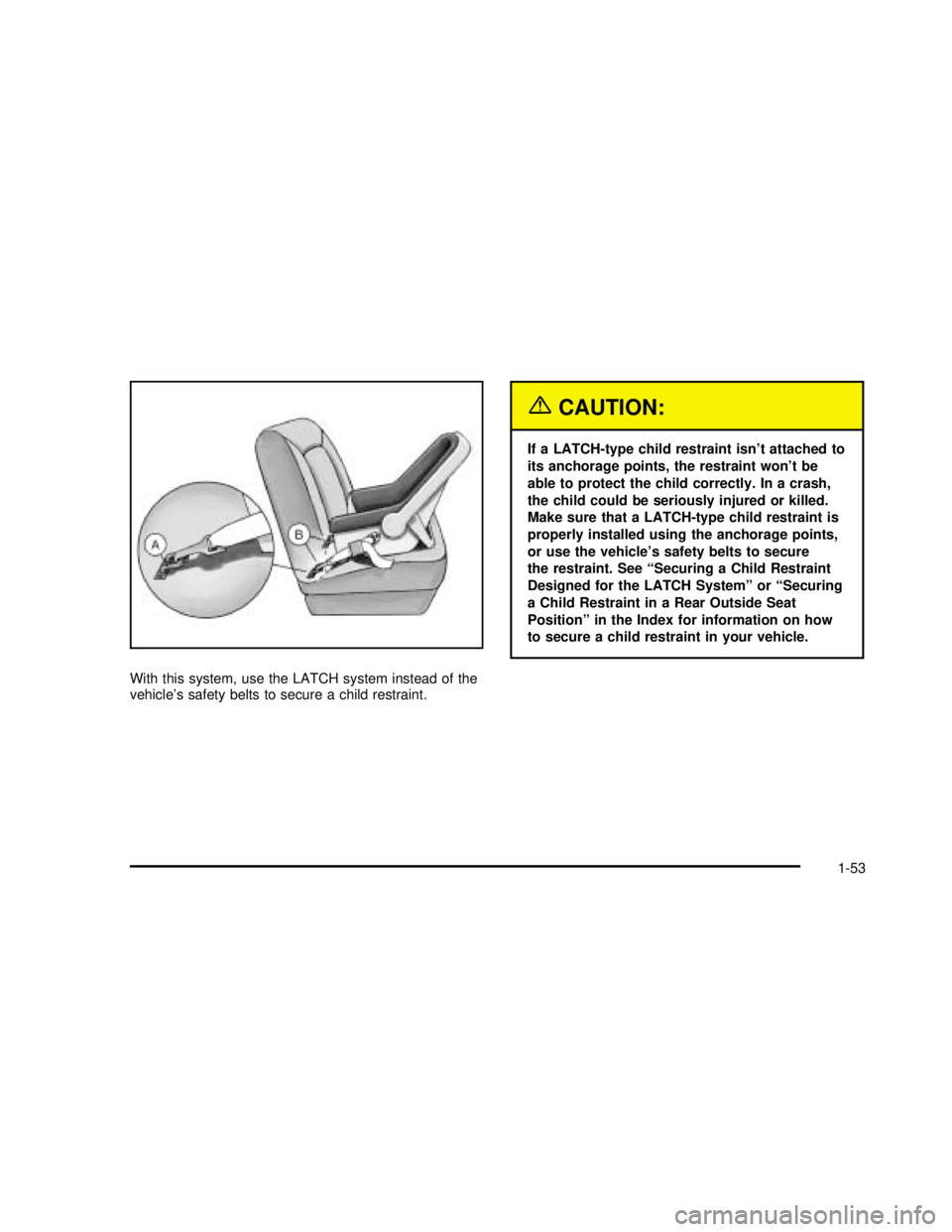
With this system, use the LATCH system instead of the
vehicle’s safety belts to secure a child restraint.
{CAUTION:
If a LATCH-type child restraint isn’t attached to
its anchorage points, the restraint won’t be
able to protect the child correctly. In a crash,
the child could be seriously injured or killed.
Make sure that a LATCH-type child restraint is
properly installed using the anchorage points,
or use the vehicle’s safety belts to secure
the restraint. See “Securing a Child Restraint
Designed for the LATCH System” or “Securing
a Child Restraint in a Rear Outside Seat
Position” in the Index for information on how
to secure a child restraint in your vehicle.
1-53
2003 - Savana OM
Page 60 of 392

Securing a Child Restraint Designed
for the LATCH System
1. Find the anchors for the seating position you want
to use, where the bottom of the seatback meets the
back of the seat cushion.
2. Put the child restraint on the seat.
3. Attach the anchor points on the child restraint
to the anchors in the vehicle. The child restraint
instructions will show you how.
4. If the child restraint is forward-facing, attach the top
strap to the top strap anchor. SeeTop Strap on
page 1-49. Tighten the top strap according to
the child restraint instructions.
5. Push and pull the child restraint in different
directions to be sure it is secure.
To remove the child restraint, simply unhook the top
strap from the top tether anchor and then disconnect
the anchor points.
Securing a Child Restraint in a
Rear Outside Seat Position
If your child restraint is equipped with the LATCH
system, SeeLower Anchorages and Top Tethers for
Children (LATCH System) on page 1-52.
You’ll be using the lap-shoulder belt. SeeTop Strap on
page 1-49if the child restraint has one. Be sure to
follow the instructions that came with the child restraint.
Secure the child in the child restraint when and as
the instructions say.
1-54
2003 - Savana OM